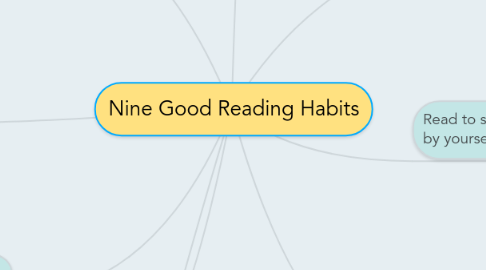Nine Good Reading Habits
by Maritza Heske

1. Build sustained personal reading time
1.1. Provide time in school to build reading time to 90 minutes in one sitting. Every other Friday, build sustained reading time. Start by reading 20 minutes. In 2 weeks, try 40. In 2 more weeks, try 60. If students can not keep this pace, slow it down
2. Read in phrases, not word for word.
2.1. Readers should look ahead as they read to chunk words together that seem to go together. There are no rules for how to phrase. It is a matter of experimenting and training your eye to look ahead
3. Learn vocabulary
3.1. Collect words! I give students these directions: (1) Find new, interesting, important, or FUN words. (2) Record them in a composition notebook. (3) Read the context and write your guess about what the word means. (4) Look up the word. (5) If you are right, check it (√). If you are wrong, choose the definition from the dictionary that matches and write it in your own words.
4. Ask constantly, Does this make sense?
4.1. A simple habit to get into is to STOP when the reader realizes he is lost. Rereading, reading slower, whisper reading, physically getting up and moving, or asking someone what a word means are all actions readers can take to get back on track
5. Set a reading goal
5.1. Keep a record of your progress. When I confer with students, the suggestions I make become the student's goal. For example, if I teach the student to find small words within big words, then that becomes the student's personal reading goal. She records it in a central place – in a daybook in my classroom – and brings her goal with her each time we confer
6. Read
6.1. Practice reading to improve. To that end, students make reading book bags. From the library, the classroom library, and home, they collect 3-5 books, comics, magazines, graphic novels or newspapers. They read on the same topic or in an author or genre series for a long time if they wish. I read, too in order to share my challenges and joys.
7. Read to someone, with someones and by yourself every day.
7.1. I ask my students to read texts 1-2 years below their reading level, on their reading level, and 1-2 years above their reading level every day if they can (Goldilocks' system). This includes all the reading they do in and out of school.
8. Set an index card to track the words if you need to.
8.1. Some readers need to track. I teach them that it is okay to use an index card and put it under the line of text they are reading. I have had students who read haltingly but once given an index card read pretty well.
9. 9. Cover the page with a colored plastic sheet to help the words settle down.
9.1. Some students with difficulties love using a non-glare piece of plastic to cover the page. Marie Carbo discovered that covering the words with plastic overlays – a color unique to each reader – helps the words stop moving for these readers.


